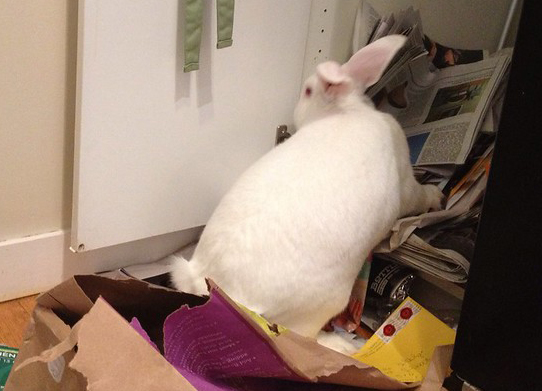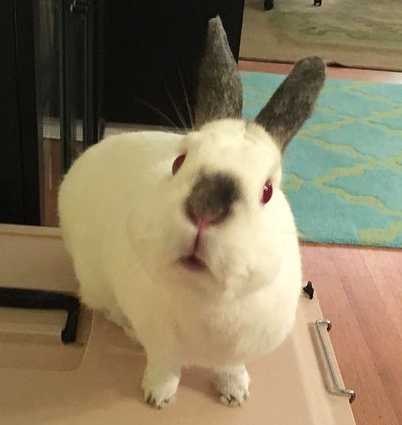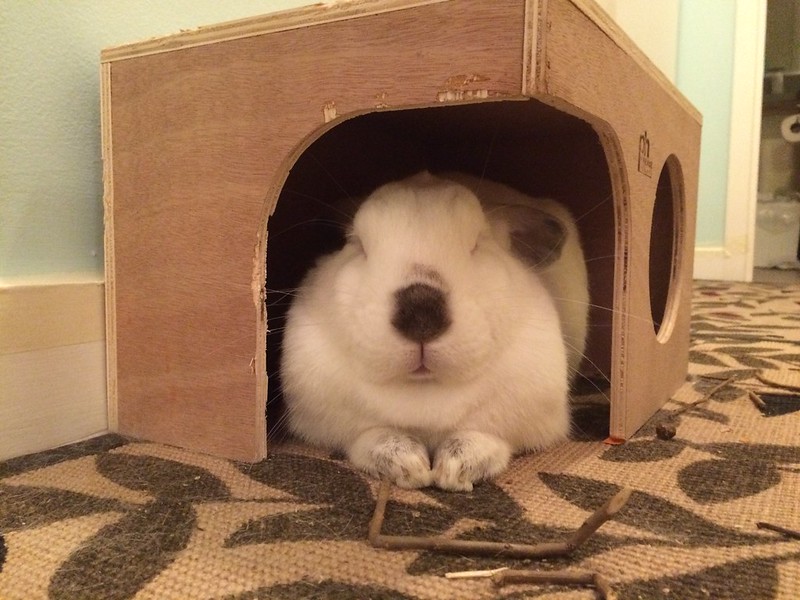
One day my husband, David, was singing the praises of our beloved bunnies to a friend whose son had had a rabbit.
Though normally humorous and erudite, the guy went quiet. Then he replied, in a grim tone suggesting traumatic tales of chew-marks too bitter to relate: “They can be very destructive.”
Sadly, I think too many people may feel the same way.
 True Confessions Regarding Rabbit Destruction
True Confessions Regarding Rabbit Destruction
- Moraea ate the walls.
- No other rabbit I’ve ever owned has eaten the walls.
- She’s worth it. (Look at that face!)
- She stopped.
- I now have a full arsenal of strategies for dealing with a wall-chewing rabbit. Just ask me.
Destructive According to Whom?
Imagine your bunny chatting with a wild rabbit about how nice humans are. The wild rabbit might respond, “I used to live in a lovely meadow. Humans came and built their above-ground burrows there. They destroyed our homes and we had to relocate. Humans are very destructive.” It’s all a matter of viewpoint, isn’t it? To one creature an activity might seem destructive, while to another it’s a sterling achievement.
To us, a wall should be a clean, smooth vertical surface with a pleasant color of paint applied whose function is to look nice, and to block light and noise from traveling from one room to the next. To your pet critter, it’s just a vertical obstruction, and possibly something to file his teeth or nails on. Any time you invite another species into your home, you must accept that the animal will interpret everything’s potential function differently than you do. Moraea wasn’t “destroying” the wall. She was “using” it for what she thought was its best application: gnawing.
“Destructive” Behavior Is a Message
What was Moraea telling me while she was grinding down my walls? Clearly, “I want to chew things!” Perhaps even “I like to chew things that are hard and solid that I can push against”? Armed with these theories, I could launch some experiments: the goal was to find things that Moraea would want to chew that were *like* my walls, but *not* my walls. I took a two-pronged approach:
- Prevention: I covered a few of her favorite wall chewing spots with clear sheets of hard plastic that were cut to size.
- Enrichment: I filled a corner of the room with cardboard boxes pushed against the walls, plus made sure she always had a changing selection of toys to play with and a good supply of fresh hay to chew on.
The result, as I mentioned, is that Moraea stopped chewing on the walls. Now she and Finnegan frequently spend time at Cardboard Corner, chewing and digging the boxes (see video below). I continue to add cardboard there when it starts to thin out, so exposed walls don’t attract unwanted attention. I keep refreshing the toy selection around the house to add variety and shift attention so that boredom doesn’t set in. You can find lots of great toys online or make your own out of discarded cardboard. Bountiful hay prevents unwanted chewing that is hunger-based.
 I had a similar experience with Clayton, a foster bunny who spent a few weeks living in our hallway. Clayton’s target was the baseboards. What might be appealing about a baseboard to a rabbit? It’s got a corner that sticks out, it’s made of wood, and it is very stable/doesn’t move around when you grind your molars on it. Here’s what worked:
I had a similar experience with Clayton, a foster bunny who spent a few weeks living in our hallway. Clayton’s target was the baseboards. What might be appealing about a baseboard to a rabbit? It’s got a corner that sticks out, it’s made of wood, and it is very stable/doesn’t move around when you grind your molars on it. Here’s what worked:
- Prevention: I covered the corners of the baseboards with painter’s tape, which made them a little less appealing to chew on.
- Enrichment: At the same time, I bought Clayton his own raw wood “house” which was pretty stable on the rug and had some nice corners for him to sink his teeth into.
Success! As you can see in the photo, Clayton transferred his chew drive over to the house, and everyone was happy!
Everyone Likes to Have a Hobby
It’s worth pointing out that It was important to supply Clayton with his new “human approved” chewing target — that house — at the same time as the tape was applied to the baseboards. Any time you ask an animal to stop doing something, you’re going to run into problems unless you give them an alternative activity. If we had taped those baseboards without supplying the house, Clayton would still have looked for something to chew that he found as satisfying. With no better alternative, he would have just adapted to chewing baseboards with tape.
Everyone wants and needs something to do! Researchers gave animals the choice between eating food just sitting out in a bowl or receiving the same food in exchange for having to perform some specific task. They found that normal, non-starving animals will choose to work for the food . Does that surprise you?
I think a lot about how nice it would be if I just had tons of money and didn’t have to work! But if that was the case, I still wouldn’t lay around on the sofa all day eating bon bons. I’d start doing more of the things I enjoy, like spending more time training rabbits, writing blog posts, volunteering at shelters, or making art. It makes sense in an evolutionary context: the animals who worked hardest would be more likely to survive.
So when you take away one of your bun’s favorite pastimes, it’s important to replace it with something that provides the same kind of pleasure.
In order to know what to offer him, you have to observe your bunny. Each rabbit is unique, as you well know if you have had more than one. Each has his own personality *and* his own favorite activities. Rabbit-proofing is as much a matter of keeping your whisker-nose busy doing fun, safe things as it is stopping him from doing things you consider unacceptable. The more you know about your rabbit’s preferred hobbies, the more effective you will be at this.
What If Your Alternative Activity Isn’t Well Received?
Sometimes you provide a replacement target for digging or chewing but your rabbit doesn’t adopt it. I once spent hours with a crochet needle knotting jute fibers into a seagrass mat, hoping it would become a good rug-eating substitute. It was completely ignored by every whisker nose in the room. Your little miscreant might try out your experiment a couple of times then go right back to using the Forbidden Thing. Or indeed, find a new Forbidden Thing! Don’t despair!
You have simply not identified the qualities of the Forbidden Thing(s) that are most important to her. You need to spend some more time thinking about the objects she is choosing and what properties they may have that are so appealing. Texture? Weight? Stability or resistance? Taste? Observe how she’s using her verboten object. Is she pulling up? Pushing against? How does it respond when she interacts with it? Then try to find another substitute that might be closer to what she’s after. Keep experimenting and take notes on your results. Sometimes it takes a few tries to find the right substitute.
This can be a challenge, but if you stick with it, you’ll be surprised how rewarding it can be. When I weighted down that jute-crested seagrass mat by pinning it underneath a wooden rabbit house, it was shredded in no time! They just needed some resistance to pull against. When you finally find something that works, it’s like you won the lottery! It’s such a joy to see and hear a bun whose activity was previously a “problem” busy working on something you’re comfortable with – something you discovered that brings them joy!
The Fluffy Tail of This Blog Post
When your long-eared lad’s vandalism gets you down, it’s time to get to know him better. He just wants a hobby. Observing his behavior will give you clues you can use to help him choose better objects to work with. Who wants a pet who just lays there? Enabling the kind of activities your rabbit loves using more appropriate target items will make both of you happy!
Amy Valbusa says:
Sometimes I wonder if cardboard is indeed safe. Read horror stories about toilet paper rolls and cardboard causing obstruction.
Also read that it’s more about the glue holding the cardboard together.
When do I find safe cardboard?
By the way, Both are both not chewers ♥️ And are not destructive 🥰
Lucky!
Melinda says:
Hi Amy!
That’s a great question! I’m not sure if there is a lot of science done on this. So many things you read online are anecdotal and not based on scientific study.
The folks I usually rely on to have at least done some due diligence on their information are the House Rabbit Society, since they are probably the best known and most well-connected rabbit rescue organization in the U.S. They do indicate that cardboard is ok. https://rabbit.org/faq-chewing/
That said, every rabbit is different. Our Pixel had terrible diarrhea for a long time. I just could not figure out what was causing it. I tried stopping the cereal, no change. removing the greens, no change. No more treats, no change. Finally I tried getting rid of every piece of paper and cardboard she had access to, and bang! No more runny poop! She also was eventually diagnosed with Mega Cecum. 🙁 Her reaction to the cardboard may have been related to that congenital disease.
A lot of rabbits just “sculpt” the cardboard – they nibble off pieces but don’t actually swallow it. This is best case scenario. But I have had plenty of rabbits who have eaten it, and have been none the worse for it.
Point is, whenever you offer anything new to a rabbit you should always introduce it gradually and monitor closely for any adverse affects. If your buns are not chewers in general, chances are they probably won’t eat the cardboard anyway but it’s important to make sure they are wearing their teeth down on something – so plenty of hay, at the very least!
I use any plain cardboard (not heavily printed). Stiffer ones tend to be favored– or ones that have treats inside!